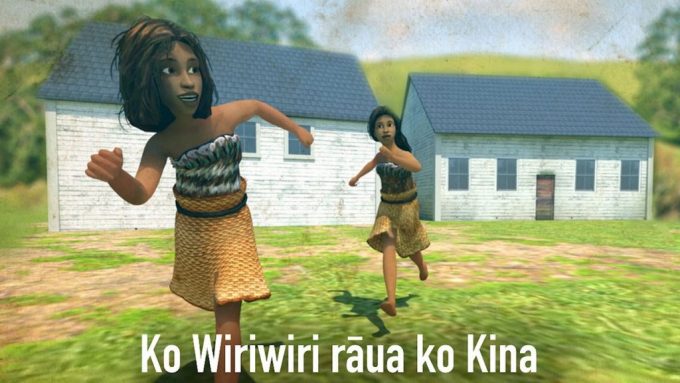
Ko Wiriwiri rāua ko Kina, a new learning app by Ruth Lemon and Hēmi Dale, produced by Kiwa Digital. Image courtesy of University of Auckland
<p>Intended as a resource for primary school classrooms, Ko Wiriwiri rāua ko Kina draws on the history of the first school in Aotearoa, which opened in Hohi, Rangihoua, Bay of Islands in 1816.</p>
<p>Designed in an attractive animated digital format, the story follows the adventures of two fictional girls, Wiriwiri and Kina, as they start school at Hohi together and learn to write their first letters and syllables in te reo.</p>
<p>It features the voice talent of Auckland teenagers Breeze and Tyme Harema-Watts, and although aimed at te reo speakers and learners, users can also access the English version.</p>
<p>The app is a collaboration between University of Auckland writer and researcher Ruth Lemon and Kiwa Digital, a Māori-owned Auckland-based software developer which specialises in Indigenous language revitalisation.</p>
<p>A professional teaching fellow in the University’s Faculty of Education and Social Work, Ruth Lemon says the story explores the dynamics between the missionaries and Māori, and addresses the common misunderstanding that missionaries were the main actors in establishing the first schools for Māori.</p>
<figure id="attachment_28417" aria-describedby="caption-attachment-28417" style="width: 480px" class="wp-caption aligncenter"><img class="wp-image-28417 size-full" src="https://www.schoolnews.co.nz/wp-content/uploads/2019/08/1566767970404.jpg" alt="Ms Ruth Lemon with Tyme Harema-Watts and Breeze Harema-Watts, the voice talent of the two girls in the app, at the launch event last Tuesday. Image courtesy of University of Auckland." width="480" height="270" /><figcaption id="caption-attachment-28417" class="wp-caption-text">Ms Ruth Lemon with Tyme Harema-Watts and Breeze Harema-Watts, the voice talent of the two girls in the app, at the launch event last Tuesday. Image courtesy of University of Auckland.</figcaption></figure>
<div class="text section">
<blockquote>
<p>“As the resource illustrates, Māori were active partners in the establishment of the first school. The Pākehā teacher needed to learn many new things, including learning the Māori language, and Māori teaching and learning approaches,” she says.</p>
</blockquote>
<p>The app’s special features include a way to create and record your own pepeha (personal introduction) and the ability to click on each individual word for pronunciation help. It also offers curriculum links, learning activities, a historical timeline for printing and sharing and an extensive list of further resources.</p>
<p>To make sure <i>Ko Wiriwiri rāua ko Kina</i> was historically accurate, Ms Lemon drew on the research of Faculty of Education and Social Work colleague Professor Alison Jones and Professor Kuni Jenkins of Te Whare Wānanga o Awanuiārangi. Māori medium educator Hēmi Dale wrote the te reo Māori story and Dr Waldo Houia and Dr Katarina Edmonds, both now at Waikato University, collaborated on the teachers’ notes.</p>
<p>Kiwa Digital’s CEO Steven Renata believes that long-term language preservation plans will only be implemented successfully if they have technology solutions at their heart.</p>
<p>“Technology is opening up exciting new <a class="wpil_keyword_link" title="opportunities" href="https://www.schoolnews.co.nz/2015/10/developing-opportunities-at-school-with-a-view/" data-wpil-keyword-link="linked" target="_blank">opportunities</a> for Indigenous groups, with immersive technology allowing Indigenous perspectives to be communicated in unique new ways,” he says.</p>
<p><i>Ko Wiriwiri rāua ko Kina </i>can be downloaded from the App Store or Google Play. Its production was supported by the Ministry of Education’s Te Aho Ngārahu fund, an initiative aimed at improving the access to quality local curriculum resources in te reo Māori.</p>
<h3>Hohi 1816</h3>
<p>Ruth Lemon is also the researcher and writer of <i>Hohi 1816</i>, a historical board game intended as a resource for early childhood, primary and secondary school teacher preparation. Themes of the game include the different motivations of settlers and Māori in the days of early engagement in Aotearoa, New Zealand, prior to the Treaty of Waitangi. </p>
<p><i>Hohi 1816</i> was designed in collaboration with Richard Durham, a learning designer in the Faculty of Education and Social Work and Minty Hunter and Bek Farr from Nectarine Ltd, a New Zealand-based graphic design company.</p>
<p>The game is now available to order as a teaching resource on the internet and was supported through contestable funding at the University of Auckland. See <a href="https://hohi1816.nz/" target="_blank">Hohi1816.nz</a> for more information.</p>
<h6><a href="https://www.auckland.ac.nz/en/news/2019/08/23/new-app-brings-history-and-te-reo-alive.html" target="_blank">This story was shared with <em>School News</em> by the University of Auckland. </a></h6>
</div>

NZEI Te Riu Roa is considering legal action against the government for the disestablishment of…
NZQA is implementing AI-marking for all Year 10 written assessments from this year onwards, following…
Teaching personal financial responsibility isn't enough. Children should be taught broader economic context, argue New…
When students can't hear the teacher, they can't learn properly. Sound quality matters in education…
The Garden City is rich with learning opportunities, no matter what subject or part of…
Teaching Council of Aotearoa launch school leaders’ stories project with Unteach Racism to challenge institutional…
This website uses cookies.